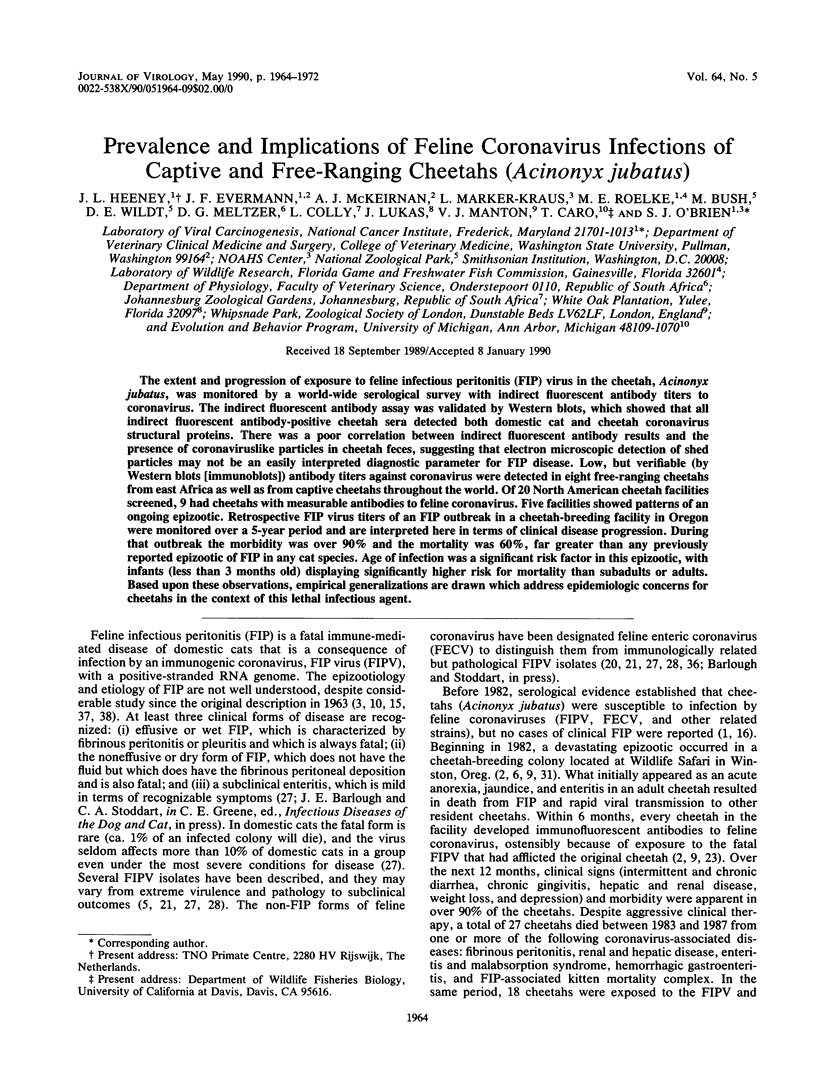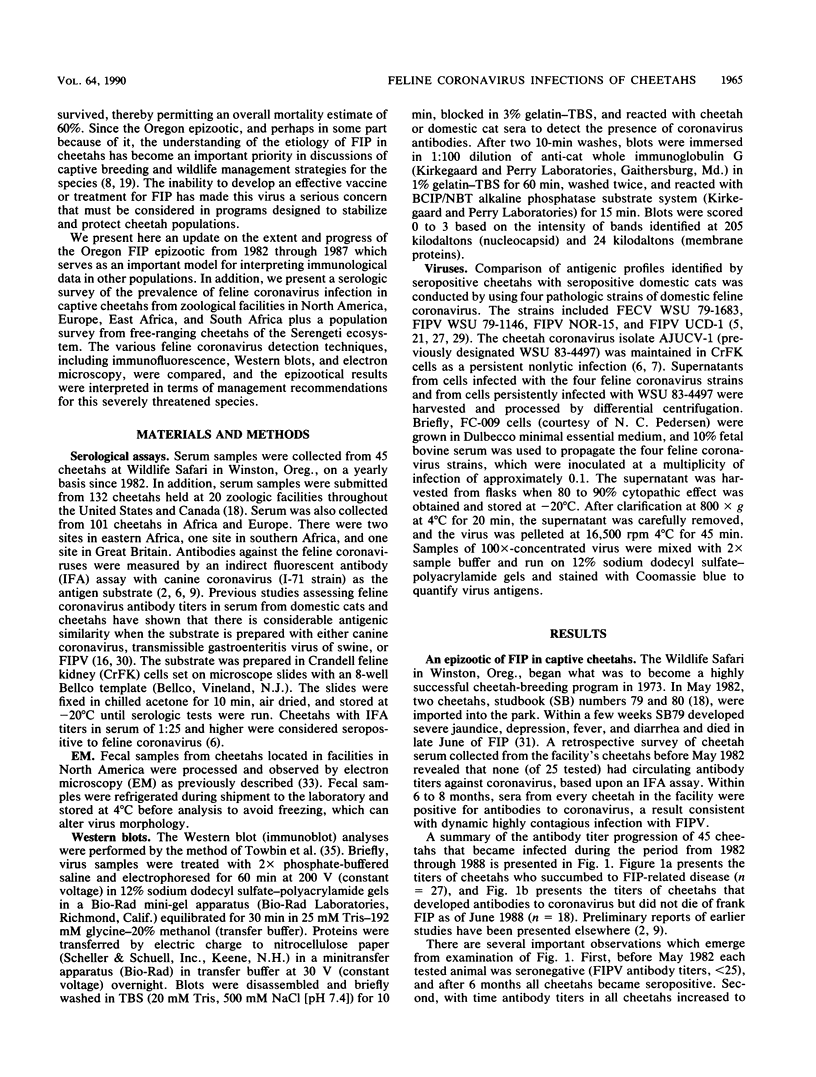Abstract
The extent and progression of exposure to feline infectious peritonitis (FIP) virus in the cheetah, Acinonyx jubatus, was monitored by a world-wide serological survey with indirect fluorescent antibody titers to coronavirus. The indirect fluorescent antibody assay was validated by Western blots, which showed that all indirect fluorescent antibody-positive cheetah sera detected both domestic cat and cheetah coronavirus structural proteins. There was a poor correlation between indirect fluorescent antibody results and the presence of coronaviruslike particles in cheetah feces, suggesting that electron microscopic detection of shed particles may not be an easily interpreted diagnostic parameter for FIP disease. Low, but verifiable (by Western blots [immunoblots]) antibody titers against coronavirus were detected in eight free-ranging cheetahs from east Africa as well as from captive cheetahs throughout the world. Of 20 North American cheetah facilities screened, 9 had cheetahs with measurable antibodies to feline coronavirus. Five facilities showed patterns of an ongoing epizootic. Retrospective FIP virus titers of an FIP outbreak in a cheetah-breeding facility in Oregon were monitored over a 5-year period and are interpreted here in terms of clinical disease progression. During that outbreak the morbidity was over 90% and the mortality was 60%, far greater than any previously reported epizootic of FIP in any cat species. Age of infection was a significant risk factor in this epizootic, with infants (less than 3 months old) displaying significantly higher risk for mortality than subadults or adults. Based upon these observations, empirical generalizations are drawn which address epidemiologic concerns for cheetahs in the context of this lethal infectious agent.
Full text
PDF








Images in this article
Selected References
These references are in PubMed. This may not be the complete list of references from this article.
- Colby E. D., Low R. J. Feline infectious peritonitis. Vet Med Small Anim Clin. 1970 Aug;65(8):783–786. [PubMed] [Google Scholar]
- De Groot R. J., Andeweg A. C., Horzinek M. C., Spaan W. J. Sequence analysis of the 3'-end of the feline coronavirus FIPV 79-1146 genome: comparison with the genome of porcine coronavirus TGEV reveals large insertions. Virology. 1988 Dec;167(2):370–376. doi: 10.1016/0042-6822(88)90097-9. [DOI] [PMC free article] [PubMed] [Google Scholar]
- Evermann J. F., Baumgartener L., Ott R. L., Davis E. V., McKeirnan A. J. Characterization of a feline infectious peritonitis virus isolate. Vet Pathol. 1981 Mar;18(2):256–265. doi: 10.1177/030098588101800214. [DOI] [PubMed] [Google Scholar]
- Evermann J. F., Heeney J. L., McKeirnan A. J., O'Brien S. J. Comparative features of a coronavirus isolated from a cheetah with feline infectious peritonitis. Virus Res. 1989 May;13(1):15–27. doi: 10.1016/0168-1702(89)90084-1. [DOI] [PMC free article] [PubMed] [Google Scholar]
- Evermann J. F., Heeney J. L., Roelke M. E., McKeirnan A. J., O'Brien S. J. Biological and pathological consequences of feline infectious peritonitis virus infection in the cheetah. Arch Virol. 1988;102(3-4):155–171. doi: 10.1007/BF01310822. [DOI] [PMC free article] [PubMed] [Google Scholar]
- FELDMANN B. M., JORTNER B. S. CLINICO-PATHOLOGIC CONFERENCE: FROM THE SCHOOL OF VETERINARY MEDICINE UNIVERSITY OF PENNSYLVANIA. J Am Vet Med Assoc. 1964 Jun 15;144:1409–1420. [PubMed] [Google Scholar]
- Fiscus S. A., Rivoire B. L., Teramoto Y. A. Epitope-specific antibody responses to virulent and avirulent feline infectious peritonitis virus isolates. J Clin Microbiol. 1987 Aug;25(8):1529–1534. doi: 10.1128/jcm.25.8.1529-1534.1987. [DOI] [PMC free article] [PubMed] [Google Scholar]
- Fiscus S. A., Teramoto Y. A. Antigenic comparison of feline coronavirus isolates: evidence for markedly different peplomer glycoproteins. J Virol. 1987 Aug;61(8):2607–2613. doi: 10.1128/jvi.61.8.2607-2613.1987. [DOI] [PMC free article] [PubMed] [Google Scholar]
- Fiscus S. A., Teramoto Y. A. Functional differences in the peplomer glycoproteins of feline coronavirus isolates. J Virol. 1987 Aug;61(8):2655–2657. doi: 10.1128/jvi.61.8.2655-2657.1987. [DOI] [PMC free article] [PubMed] [Google Scholar]
- Fiscus S. A., Teramoto Y. A., Mildbrand M. M., Knisley C. V., Winston S. E., Pedersen N. C. Competitive enzyme immunoassays for the rapid detection of antibodies to feline infectious peritonitis virus polypeptides. J Clin Microbiol. 1985 Sep;22(3):395–401. doi: 10.1128/jcm.22.3.395-401.1985. [DOI] [PMC free article] [PubMed] [Google Scholar]
- HOLZWORTH J. Some important disorders of cats. Cornell Vet. 1963 Jan;53:157–160. [PubMed] [Google Scholar]
- Horzinek M. C., Osterhaus A. D. Feline infectious peritonitis: a worldwide serosurvey. Am J Vet Res. 1979 Oct;40(10):1487–1492. [PubMed] [Google Scholar]
- McKeirnan A. J., Evermann J. F., Davis E. V., Ott R. L. Comparative properties of feline coronaviruses in vitro. Can J Vet Res. 1987 Apr;51(2):212–216. [PMC free article] [PubMed] [Google Scholar]
- O'Brien S. J., Roelke M. E., Marker L., Newman A., Winkler C. A., Meltzer D., Colly L., Evermann J. F., Bush M., Wildt D. E. Genetic basis for species vulnerability in the cheetah. Science. 1985 Mar 22;227(4693):1428–1434. doi: 10.1126/science.2983425. [DOI] [PubMed] [Google Scholar]
- O'Brien S. J., Wildt D. E., Bush M., Caro T. M., FitzGibbon C., Aggundey I., Leakey R. E. East African cheetahs: evidence for two population bottlenecks? Proc Natl Acad Sci U S A. 1987 Jan;84(2):508–511. doi: 10.1073/pnas.84.2.508. [DOI] [PMC free article] [PubMed] [Google Scholar]
- O'brien S. J., Wildt D. E., Goldman D., Merril C. R., Bush M. The cheetah is depauperate in genetic variation. Science. 1983 Jul 29;221(4609):459–462. doi: 10.1126/science.221.4609.459. [DOI] [PubMed] [Google Scholar]
- Pedersen N. C., Evermann J. F., McKeirnan A. J., Ott R. L. Pathogenicity studies of feline coronavirus isolates 79-1146 and 79-1683. Am J Vet Res. 1984 Dec;45(12):2580–2585. [PubMed] [Google Scholar]
- Pedersen N. C., Ward J., Mengeling W. L. Antigenic relationship of the feline infectious peritonitis virus to coronaviruses of other species. Arch Virol. 1978;58(1):45–53. doi: 10.1007/BF01315534. [DOI] [PMC free article] [PubMed] [Google Scholar]
- Pfeifer M. L., Evermann J. F., Roelke M. E., Gallina A. M., Ott R. L., McKeirnan A. J. Feline infectious peritonitis in a captive cheetah. J Am Vet Med Assoc. 1983 Dec 1;183(11):1317–1319. [PubMed] [Google Scholar]
- Spaan W., Cavanagh D., Horzinek M. C. Coronaviruses: structure and genome expression. J Gen Virol. 1988 Dec;69(Pt 12):2939–2952. doi: 10.1099/0022-1317-69-12-2939. [DOI] [PubMed] [Google Scholar]
- Stoddart C. A., Barlough J. E., Scott F. W. Experimental studies of a coronavirus and coronavirus-like agent in a barrier-maintained feline breeding colony. Arch Virol. 1984;79(1-2):85–94. doi: 10.1007/BF01314306. [DOI] [PMC free article] [PubMed] [Google Scholar]
- Stoddart M. E., Gaskell R. M., Harbour D. A., Gaskell C. J. Virus shedding and immune responses in cats inoculated with cell culture-adapted feline infectious peritonitis virus. Vet Microbiol. 1988 Feb;16(2):145–158. doi: 10.1016/0378-1135(88)90039-9. [DOI] [PMC free article] [PubMed] [Google Scholar]
- Towbin H., Staehelin T., Gordon J. Electrophoretic transfer of proteins from polyacrylamide gels to nitrocellulose sheets: procedure and some applications. Proc Natl Acad Sci U S A. 1979 Sep;76(9):4350–4354. doi: 10.1073/pnas.76.9.4350. [DOI] [PMC free article] [PubMed] [Google Scholar]
- Tupper G. T., Evermann J. F., Russell R. G., Thouless M. E. Antigenic and biological diversity of feline coronaviruses: feline infectious peritonitis and feline enteritis virus. Arch Virol. 1987;96(1-2):29–38. doi: 10.1007/BF01310988. [DOI] [PMC free article] [PubMed] [Google Scholar]
- Wolfe L. G., Griesemer R. A. Feline infectious peritonitis. Pathol Vet. 1966;3(3):255–270. doi: 10.1177/030098586600300309. [DOI] [PubMed] [Google Scholar]
- Yamamoto J. K., Hansen H., Ho E. W., Morishita T. Y., Okuda T., Sawa T. R., Nakamura R. M., Pedersen N. C. Epidemiologic and clinical aspects of feline immunodeficiency virus infection in cats from the continental United States and Canada and possible mode of transmission. J Am Vet Med Assoc. 1989 Jan 15;194(2):213–220. [PubMed] [Google Scholar]
- Yuhki N., O'Brien S. J. DNA variation of the mammalian major histocompatibility complex reflects genomic diversity and population history. Proc Natl Acad Sci U S A. 1990 Jan;87(2):836–840. doi: 10.1073/pnas.87.2.836. [DOI] [PMC free article] [PubMed] [Google Scholar]
- Zhou Y. L., Ederveen J., Egberink H., Pensaert M., Horzinek M. C. Porcine epidemic diarrhea virus (CV 777) and feline infectious peritonitis virus (FIPV) are antigenically related. Arch Virol. 1988;102(1-2):63–71. doi: 10.1007/BF01315563. [DOI] [PMC free article] [PubMed] [Google Scholar]




